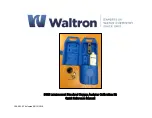
10
i
f
R
R
1
increases, such that the output voltage can, with large ratios of R
f
/ R
i
, become large enough to result in a large
E
o
, perhaps large enough to be outside the normal output voltage range of the charge amplifier.
Because of the feedback capacitor C
f
, this output voltage change usually does not occur rapidly but rather, it
manifests itself as a slow drift in the output voltage level. If R
i
is low enough with respect to R
f
, the voltage drift
may continue until saturation of the charge amplifier occurs.
5.3 Solution to Reduced Resistance
Since the drift or offset problem is caused by a static or steady-state imbalance at the input of the charge
amplifier, the solution involves blocking this steady-state effect while allowing the desired dynamic phenomena
to pass. This may be accomplished by installing a series capacitor at the input of the charge amplifier,
between the offending sensor (or low-impedance hardline) and the input.
Figure 5.2 Piezoelectric System Block Diagram
Figure 5.2 illustrates a block diagram of the piezo-electric system where:
C
t
= Shunt capacitor
C
s
= Series blocking capacitor
With the series blocking capacitor C
s
in place as shown, the dynamic charge (Q) generated by the sensor
element is distributed across the two capacitors, C
t
and C
s
, in proportion to the size (capacitance) of each. If
C
s
, for example, is equal to 100 times C
t
, 99% of the charge appears at the input of the charge amplifier, while
1% is across the shunt capacitor C
t
. This results in a 1% decrease in apparent sensitivity of the system.
This therefore demonstrates the importance of selecting the series blocking capacitor at least two orders of
magnitude higher than the total shunt capacitance C
t
across the input of the charge amplifier.
It is also important that this capacitor be of high quality, with a leakage resistance of greater that 10
12
ohms, to
avoid the DC offset discussed previously in 5.1, Introduction.
5.4 Low-Frequency Response Limitations
Summary of Contents for EX619A11
Page 23: ...DWG 62689 REV NR DIN 44641...
Page 24: ...DWG 62689 REV NR DIN 44641...
Page 25: ...DWG 62689 REV NR DIN 44641...
Page 26: ...DWG 62690 REV NR DIN 44641...
Page 27: ...DWG 62690 REV NR DIN 44641...
Page 28: ...DWG 62690 REV NR DIN 44641...
















































